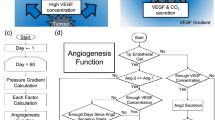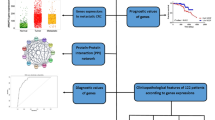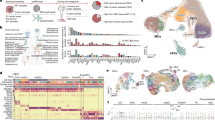Abstract
Angiopoietin-1 (Ang1) has been shown to act as an angiogenic promoter in embryonic angiogenesis by promoting vascular branching, pericyte recruitment and endothelial survival. We have investigated the role of Ang1 in tumour neovascularization under clinical conditions and in animal models. The expression of Ang1 in clinical breast cancer specimens was analysed by using laser-capture microdissection and reverse transcriptase-linked polymerase chain reaction (RT-PCR) on RNA isolated from the samples. Despite the expression of Ang1 in many human breast cancer cell lines, the gene was expressed in only three of 21 breast cancer clinical specimens, even though its receptor, Tie2, is abundant in the vasculature of all of these tumours. Ang1 was then overexpressed in a human breast cancer cell line (MCF-7) on its own and in conjunction with FGF1, an angiogenic factor shown to be able to increase the tumorigenicity of MCF-7 cells. High concentrations of Ang1 were produced in the conditioned media of the transfected cells (range 156–820 ng ml–1). However, in contrast to its physiological role as promoter of angiogenesis, overexpression of Ang1 did not enhance tumour growth, but instead caused up to a 3-fold retardation of tumour growth (P = 0.003). © 2000 Cancer Research Campaign
Similar content being viewed by others
Article PDF
Change history
16 November 2011
This paper was modified 12 months after initial publication to switch to Creative Commons licence terms, as noted at publication
References
Asahara T, Chen D, Takahashi T, Fujikawa K, Kearney M, Magner M, Yancopoulos GD and Isner JM (1998) Tie2 receptor ligands, angiopoietin-1 and angiopoietin-2, modulate VEGF-induced postnatal neovascularization. Circ Res 83: 233–240
Carmeliet P, Ferreira V, Breier G, Pollefeyt S, Kieckens L, Gertsenstein M, Fahrig M, Vandenhoeck A, Harpal K, Eberhardt C, Declercq C, Pawling J, Moons L, Collen D, Risau W and Nagy A (1996) Abnormal blood vessel development and lethality in embryos lacking a single VEGF allele. Nature 380: 435–439
Davis S, Aldrich TH, Jones PF, Acheson A, Compton DL, Jain V, Ryan TE, Bruno J, Radziejewski C, Maisonpierre PC and Yancopoulos GD (1996) Isolation of angiopoietin-1, a ligand for the TIE2 receptor, by secretion-trap expression cloning. Cell 87: 1161–1169
de Vries C, Escobedo JA, Ueno H, Houck K, Ferrara N and Williams LT (1992) The fms-like tyrosine kinase, a receptor for vascular endothelial growth factor. Science 255: 989–991
Dumont DJ, Gradwohl GJ, Fong GH, Auerbach R and Breitman ML (1993) The endothelial-specific receptor tyrosine kinase, tek, is a member of a new subfamily of receptors. Oncogene 8: 1293–1301
Dumont DJ, Fong GH, Puri MC, Gradwohl G, Alitalo K and Breitman ML (1995) Vascularization of the mouse embryo: a study of flk-1, tek, tie, and vascular endothelial growth factor expression during development. Dev Dyn 203: 80–92
Emmert-Buck MR, Bonner RF, Smith PD, Chuaqui RF, Zhuang Z, Goldstein SR, Weiss RA and Liotta LA (1996) Laser capture microdissection. Science 274: 998–1001
Ferrara N, Carver-Moore K, Chen H, Dowd M, Lu L, O'Shea KS, Powell-Braxton L, Hillan KJ and Moore MW (1996) Heterozygous embryonic lethality induced by targeted inactivation of the VEGF gene. Nature 380: 439–442
Folkman J (1971) Tumor angiogenesis: therapeutic implications. N Engl J Med 285: 1182–1186
Hanahan D and Folkman J (1996) Patterns and emerging mechanisms of the angiogenic switch during tumorigenesis. Cell 86: 353–364
Hayes AJ, Huang WQ, Mallah J, Yang D, Lippman ME and Li LY (1999) Angiopoietin-1 and its receptor Tie-2 participate in the regulation of capillary-like tubule formation and survival of endothelial cells. Microvasc Res 58: 224–237
Holash J, Maisonpierre PC, Compton D, Boland P, Alexander CR, Zagzag D, Yancopoulos GD and Wiegand SJ (1999) Vessel cooption, regression, and growth in tumors mediated by angiopoietins and VEGF. Science 284: 1994–1998
Koblizek TI, Weiss C, Yancopoulos GD, Deutsch U and Risau W (1998) Angiopoietin-1 induces sprouting angiogenesis in vitro. Curr Biol 8: 529–532
Kurebayashi J, McLeskey SW, Johnson MD, Lippman ME, Dickson RB and Kern FG (1993) Quantitative demonstration of spontaneous metastasis by MCF-7 human breast cancer cells cotransfected with fibroblast growth factor 4 and LacZ. Cancer Res 53: 2178–2187
Lehtola L, Partanen J, Sistonen L, Korhonen J, Warri A, Harkonen P, Clarke R and Alitalo K (1992) Analysis of tyrosine kinase mRNAs including four FGF receptor mRNAs expressed in MCF-7 breast-cancer cells. Int J Cancer 50: 598–603
Maisonpierre PC, Goldfarb M, Yancopoulos GD and Gao G (1993) Distinct rat genes with related profiles of expression define a TIE receptor tyrosine kinase family. Oncogene 8: 1631–1637
Maisonpierre PC, Suri C, Jones PF, Bartunkova S, Wiegand SJ, Radziejewski C, Compton D, McClain J, Aldrich TH, Papadopoulos N, Daly TJ, Davis S, Sato TN and Yancopoulos GD (1997) Angiopoietin-2, a natural antagonist for Tie2 that disrupts in vivo angiogenesis. Science 277: 55–60
McLeskey SW, Kurebayashi J, Honig SF, Zwiebel J, Lippman ME, Dickson RB and Kern FG (1993) Fibroblast growth factor 4 transfection of MCF-7 cells produces cell lines that are tumorigenic and metastatic in ovariectomized or tamoxifen-treated athymic nude mice. Cancer Res 53: 2168–2177
McLeskey SW, Tobias CA, Vezza PR, Filie AC, Kern FG and Hanfelt J (1998) Tumor growth of FGF or VEGF transfected MCF-7 breast carcinoma cells correlates with density of specific microvessels independent of the transfected angiogenic factor. Am J Pathol 153: 1993–2006
Papapetropoulos A, Garcia-Cardena G, Dengler TJ, Maisonpierre PC, Yancopoulos GD and Sessa WC (1999) Direct actions of angiopoietin-1 on human endothelium: evidence for network stabilization, cell survival, and interaction with other angiogenic growth factors. Lab Invest 79: 213–223
Relf M, LeJeune S, Scott PA, Fox S, Smith K, Leek R, Moghaddam A, Whitehouse R, Bicknell R and Harris AL (1997) Expression of the angiogenic factors vascular endothelial cell growth factor, acidic and basic fibroblast growth factor, tumor growth factor beta-1, platelet-derived endothelial cell growth factor, placenta growth factor, and pleiotrophin in human primary breast cancer and its relation to angiogenesis. Cancer Res 57: 963–969
Sato TN, Tozawa Y, Deutsch U, Wolburg-Buchholz K, Fujiwara Y, Gendron-Maguire M, Gridley T, Wolburg H, Risau W and Qin Y (1995) Distinct roles of the receptor tyrosine kinases Tie-1 and Tie-2 in blood vessel formation. Nature 376: 70–74
Shalaby F, Rossant J, Yamaguchi TP, Gertsenstein M, Wu XF, Breitman ML and Schuh AC (1995) Failure of blood-island formation and vasculogenesis in Flk-1-deficient mice. Nature 376: 62–66
Stratmann A, Risau W and Plate KH (1998) Cell type-specific expression of angiopoietin-1 and angiopoietin-2 suggests a role in glioblastoma angiogenesis. Am J Pathol 153: 1459–1466
Suri C, Jones PF, Patan S, Bartunkova S, Maisonpierre PC, Davis S, Sato TN and Yancopoulos GD (1996) Requisite role of angiopoietin-1, a ligand for the TIE2 receptor, during embryonic angiogenesis. Cell 87: 1171–1180
Suri C, McClain J, Thurston G, McDonald DM, Zhou H, Oldmixon EH, Sato TN and Yancopoulos GD (1998) Increased vascularization in mice overexpressing angiopoietin-1. Science 282: 468–471
Takebe Y, Seiki M, Fujisawa J, Hoy P, Yokota K, Arai K, Yoshida M and Arai N (1988) SR alpha promoter: an efficient and versatile mammalian cDNA expression system composed of the simian virus 40 early promoter and the R-U5 segment of human T-cell leukemia virus type 1 long terminal repeat. Mol Cell Biol 8: 466–472
Terman BI, Dougher-Vermazen M, Carrion ME, Dimitrov D, Armellino DC, Gospodarowicz D and Bohlen P (1992) Identification of the KDR tyrosine kinase as a receptor for vascular endothelial cell growth factor. Biochem Biophys Res Commun 187: 1579–1586
Thurston G, Suri C, Smith K, McClain J, Sato TN, Yancopoulos GD and McDonald DM (1999) Leakage-resistant blood vessels in mice transgenically overexpressing angiopoietin-1. Science 286: 2511–2514
Weidner N (1995) Current pathologic methods for measuring intratumoral microvessel density within breast carcinoma and other solid tumors. Breast Cancer Res Treat 36: 169–180
Zagzag D, Hooper A, Friedlander DR, Chan W, Holash J, Wiegand SJ, Yancopoulos GD and Grumet M (1999) In situ expression of angiopoietins in astrocytomas identifies angiopoietin-2 as an early marker of tumor angiogenesis. Exp Neurol 159: 391–400
Zhang L, Kharbanda S, Chen D, Bullocks J, Miller DL, Ding IY, Hanfelt J, McLeskey SW and Kern FG (1997) MCF-7 breast carcinoma cells overexpressing FGF-1 form vascularized, metastatic tumors in ovariectomized or tamoxifen-treated nude mice. Oncogene 15: 2093–2108
Author information
Authors and Affiliations
Rights and permissions
From twelve months after its original publication, this work is licensed under the Creative Commons Attribution-NonCommercial-Share Alike 3.0 Unported License. To view a copy of this license, visit http://creativecommons.org/licenses/by-nc-sa/3.0/
About this article
Cite this article
Hayes, A., Huang, WQ., Yu, J. et al. Expression and function of angiopoietin-1 in breast cancer. Br J Cancer 83, 1154–1160 (2000). https://doi.org/10.1054/bjoc.2000.1437
Received:
Revised:
Accepted:
Published:
Issue date:
DOI: https://doi.org/10.1054/bjoc.2000.1437
Keywords
This article is cited by
-
Helicobacter pylori infection induces abnormal expression of pro-angiogenic gene ANGPT2 and miR-203a in AGS gastric cell line
Brazilian Journal of Microbiology (2023)
-
The Effect of miR-98 and miR-214 on Apoptotic and Angiogenic Pathways in Hepatocellular Carcinoma HepG2 Cells
Indian Journal of Clinical Biochemistry (2020)
-
Amniotic Membrane Enhance the Effect of Vascular Endothelial Growth Factor on the Angiogenic Marker Expression of Stem Cells from Human Exfoliated Deciduous Teeth
Applied Biochemistry and Biotechnology (2020)
-
Human Placental-Derived Adherent Stromal Cells Co-Induced with TNF-α and IFN-γ Inhibit Triple-Negative Breast Cancer in Nude Mouse Xenograft Models
Scientific Reports (2018)
-
VEGF, ANGPT1, ANGPT2, and MMP-9 expression in the autologous hematopoietic stem cell transplantation and its impact on the time to engraftment
Annals of Hematology (2017)



